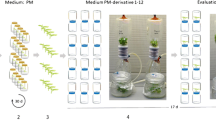Abstract
In an attempt to overcome maturation affects and loss of juvenile characteristics, when using adult plant material in vitro, investigations were undertaken into the the use of coppice material, as an alternative. Trees from 5 age groups (2, 4, 6, 8 and 10-years-old, respectively) of Acacia mearnsii were felled to a height of 1.5 m. After 3 weeks, coppice was noted on the stumps of trees of all the age groups. A linear degree of coppice production was noted between the age groups, with the greatest coppice production being on the 2-year-old trees and least on the 10-year-old trees. Decontamination of the coppice was successful and multiple shoot production was obtained from all age groups on Murashige and Skoog (MS) medium supplemented with 2.0 mg l−1 benzyladenine (BA). Various sucrose concentrations were investigated and it was noted that greater shoot production occurred with increased sucrose concentrations (20 and 30 g l−1). It is evident that rejuvenation of mature tissue can be achieved through the use of coppice material. This technique can now be used for future breeding programmes for the black wattle.
Similar content being viewed by others
References
Beard JS (1957) A Manual for Growing Wattle. Pietermaritzburg: Natal Tanning Extract Company Limited, pp 1-11
Bonga JM (1987) Clonal propagation of mature trees: Problems and possible solutions. In: Bonga JM and Durzan DJ (eds) Cell and Tissue Culture in Forestry, Vol. 1. General Principles and Biotechnology. Martinus Nijhoff Publishers, pp 387-413
Bonga JM and von Aderkas PV (1992) In vitro Culture of Trees. Kluwer Academic Publishers, pp 72-123
Chauvin JE and Salesses G (1988) Advances in chestnut micropropagation (Castanea spp.). Acta Hortic Sci 58: 23-29
Economou AS and Spanoudaki MJ (1988) Regeneration in vitro of oleaster (Elaeagnus angustifolia L.) from shoot tips of mature trees. Acta Hortic 227: 363-368
Franclet A, Boulay M, Bekkaoui F, Fouret Y, Verschoore-Artouzet B and Walker N (1987) In: Bonga JM and Durzan DJ (eds) Cell and Tissue Culture in Forestry, Vol. 1. Martinus Nijhof Publishers, pp 232-248
Gupta PK, Pullman G, Timmis R, Kreitinger M, Carlson WC, Grob J and Wetty E (1993) Forestry in the 21st Century: The biotechnology of somatic embryogenesis. Bio/Tech 11: 454- 459
Hackett WP (1985) Juvenilty, maturation, rejuvenation. Hort Rev 7: 109-147
Hackett WP (1987) Juvenility and maturity. In: Bonga JM and Durzan DJ (eds) Cell and Tissue Culture in Forestry, Vol. 1. Martinus Nijhof Publishers, pp 216-231
Hackett WP (1988) Donor plant maturation and adventitious root formation. In: Davis TD, Haissig BE and Sankhla AN (eds) Adventitious Root Formation in Cuttings. Oregon: Dioscorides Press, Portland, pp 11-28
Han K, Shin D and Keathley DE (1997) Tissue culture responses of explants taken from branch sources with different degrees of juvenility in mature black locust (Robinia pseudoacacia) trees. Tree Physiol 17: 671-675
Huang FH, Al-Khayri JM and Gbur EE (1994) Micropropagation of Acacia mearnsii. In Vitro Cell Dev Biol 30P: 70-74
Jones C, Smith D, Gifford H and Nicholas I (1991) Field trial results of Acacia melanoxylon from tissue culture. Proc Int Plant Prop Soc 41: 116-119
Jones NB and van Staden J (1997) Micropropagation of Eucalypts. In: Bajaj YPS (ed) Biotechnology in Agriculture and Forestry, Vol. 39, High-Tech and Micropropagation, V. Springer-Verlag, pp 286-329
Monteuuis O, Vallauri D, Poupard C and Chauviere M (1995) Rooting Acacia mangium cuttings of different physiological age with reference to leaf morphology as a phase change marker. Silv Genet 44: 150-154
Poupard C, Chauviere M and Monteuuis O (1994) Rooting Acacia mangium cuttings: effect of age, within-shoot position and auxin treatment. Silv Genet 43: 226-231
Reddy PC, Veerana P, Gouda P, Prasad TG, Padma K, Udayakumar M and Patil V (1995) In vitro axillary bud break and multiple shoot production in Acacia auriculiformis by tissue culture technique. Cur Sci 69: 495-496
Roux J, Kemp GHJ and Wingfield MJ (1995) Diseases of Black Wattle in South Africa - A Review. S Afri For J 174: 35-40
Sanchez MC and Vietez AM (1991) In vitro morphogenic competence of basal sprouts and crown branches of mature chestnut. Tree Physiol 8: 59-70
Thorpe TA, Harry IS and Kumar PP (1991) Application of micropropagation to forestry. In: Debergh PC and Zimmerman RH (eds) Micropropagation. Dordrecht: Kluwer Academic Publishers, pp 311-335
Toda T, Tajima M and Brini PB (1995) Tissue culture of Acacia mangium and Acacia auriculiformis and Acacia hybrid. Bulletin of the National Tree Breeding Centre 13: 81-94
Wantanabe Y, Ide Y and Ikeda A (1994) Plant regeneration from axillary bud culture of one-year-old seedling of Acacia auriculiformis grown in green house. Bulletin of the Tokyo Univ For 92: 29-35
Zhang HW, Huang XL, Fu J, Yang MQ and Chen CQ (1995) Axillary bud culture and plantlet regeneration of Acacia auriculiformis and Acacia mangium. J Tropical Subtr Bot 3: 62-68
Author information
Authors and Affiliations
Rights and permissions
About this article
Cite this article
Beck, S.L., Dunlop, R. & van Staden, J. Rejuvenation and micropropagation of adult Acacia mearnsii using coppice material. Plant Growth Regulation 26, 149–153 (1998). https://doi.org/10.1023/A:1006179620554
Issue Date:
DOI: https://doi.org/10.1023/A:1006179620554




